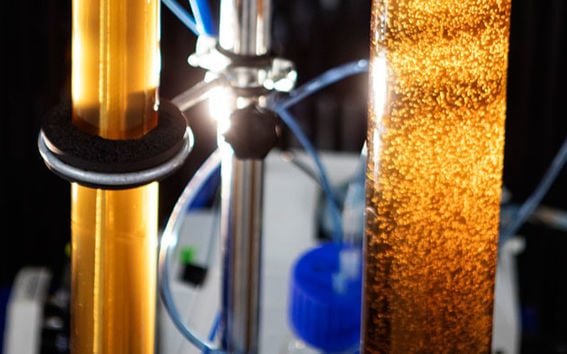A new method for converting wastewater nutrients into fertiliser

Researchers of Aalto University have developed a new, energy-efficient method for capturing nitrogen and phosphorus from different liquid waste fractions. In laboratory studies, with the help of the method, it is possible to separate 99% of the nitrogen and 90-99% of phosphorus in wastewater and produce granular ammonium sulphate (NH4)2SO4 and phosphorus precipitate suitable for fertilisers.
'There are many different methods for removing nitrogen and phosphorus from wastewater, but none of them meets the need of capturing their nutrients. It is estimated that the industrial production of nitrogen used for fertilisers is responsible for approximately 2% of the entire world's energy consumption. By capture of nutrients from communities' wastewater it is possible to supplement 6% of the industrially produced ammoniacal nitrogen and about one-tenth of phosphorus used for fertilisers', says Riku Vahala, Professor of Water and Wastewater Engineering at Aalto University.
The construction of pilot equipment at the laboratory of Water and Environmental Technology at Aalto University will begin in spring 2017. The main objective of the project is to develop an economically profitable process and operation chain for the recycling of nutrients of liquid waste fractions. Simultaneously, entrepreneurs in the field will be encouraged to migrate towards efficient wastewater treatment. Increased efficiency in nutrient capture will reduce nutrient load in the Baltic Sea, reduce the costs of wastewater treatment and promote recycling of nutrients.
'The specific beneficiaries in the project include wastewater treatment plants, sludge producers and handlers, biogas plants and the end users of fertilisers, who will get a sustainable fertiliser product for their use', says Surendra Pradhan, DSc (Tech).
The capture method is based on the use of calcium hydroxide Ca(OH)2 to convert ammoniacal nitrogen NH4+ into ammoniacal gas NH3, which are separated through a semi-permeable membrane. Following this, the ammonium is dissolved into sulphuric acid to produce ammonium sulphate. In the process, the phosphorus is precipitated with the help of calcium salt.
'A patent application for the method is currently under way, and the aim of the project is to find company partners who could make use of the patent in the best possible manner, create products with its help and market the new process. If successful, the new process will also create a competitive export product', Anna Mikola, DSc (Tech), points out.
The method also has significant positive impacts on the environment.
'Nutrient emissions to waterways will decrease, and the energy savings and reduced use of chemicals in the production of fertilisers will lower the amount of greenhouse gases', Professor Vahala reminds us.
The Raki2 2016–2019 programme promoting nutrient recycling and improvement of the state of Saaristomeri granted €457,500 to Aalto University on 9.11.2016 for a project which develops methods of capture of nitrogen and phosphorus from liquid waste. The Raki programme belongs to the government's spearhead projects, and its purpose is to fund programmes which promote nutrient recycling, reduce the nutrient load of the Baltic Sea and make the water protection of the drainage areas of agriculture to Saaristomeri and Selkämeri more efficient.
For more information:
Professor Riku Vahala, [email protected], tel. +358 50 588 4237
Postdoctoral researcher, Anna Mikola, DSc (Tech), [email protected], tel. +358 40 717 6552
Surendra Pradhan, DSc (Tech), [email protected], tel. +358 40 097 3372
- Published:
- Updated:
Read more news

In low-hierarchy organisations, even key policy issues are discussed in Slack
In a recent study, Aalto University alumn Lauri Pietinalho, a visiting scholar at New York University's Stern School of Business, and Frank Martela, an assistant professor at Aalto University, investigated how low-hierarchy organisations deal with shared policies in confrontational situations and how authority functions within them.
Getting bacteria into line
Physicists use magnetic fields to manipulate bacterial behaviour
Nordic researchers develop predictive model for cross-border COVID spread
The uniquely multinational and cross-disciplinary research was made possible by transparent data-sharing between Nordic countries.